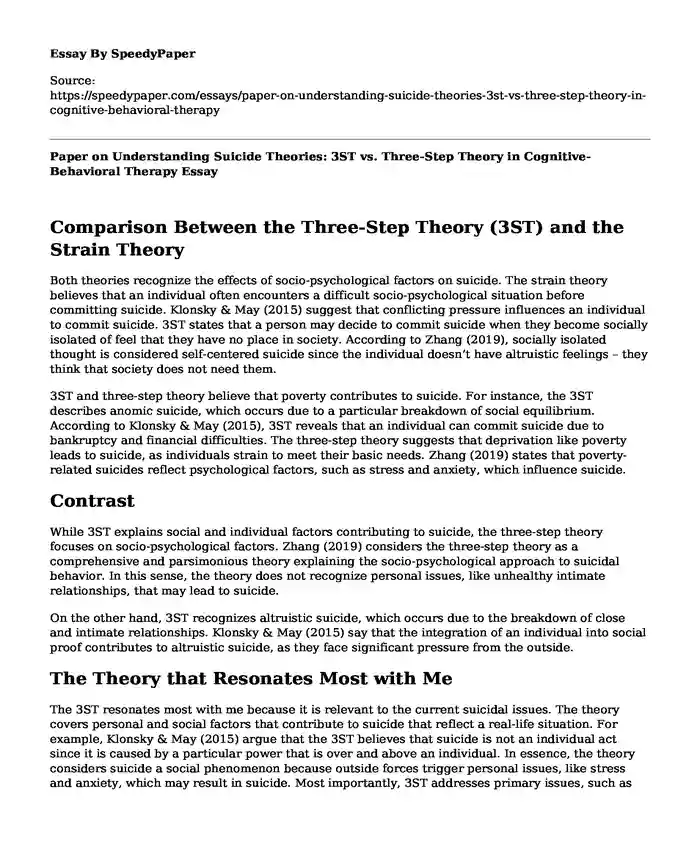
| Type of paper: | Essay |
| Categories: | Psychology Sociology Behavior |
| Pages: | 3 |
| Wordcount: | 667 words |
Comparison Between the Three-Step Theory (3ST) and the Strain Theory
Both theories recognize the effects of socio-psychological factors on suicide. The strain theory believes that an individual often encounters a difficult socio-psychological situation before committing suicide. Klonsky & May (2015) suggest that conflicting pressure influences an individual to commit suicide. 3ST states that a person may decide to commit suicide when they become socially isolated of feel that they have no place in society. According to Zhang (2019), socially isolated thought is considered self-centered suicide since the individual doesn’t have altruistic feelings – they think that society does not need them.
3ST and three-step theory believe that poverty contributes to suicide. For instance, the 3ST describes anomic suicide, which occurs due to a particular breakdown of social equilibrium. According to Klonsky & May (2015), 3ST reveals that an individual can commit suicide due to bankruptcy and financial difficulties. The three-step theory suggests that deprivation like poverty leads to suicide, as individuals strain to meet their basic needs. Zhang (2019) states that poverty-related suicides reflect psychological factors, such as stress and anxiety, which influence suicide.
Contrast
While 3ST explains social and individual factors contributing to suicide, the three-step theory focuses on socio-psychological factors. Zhang (2019) considers the three-step theory as a comprehensive and parsimonious theory explaining the socio-psychological approach to suicidal behavior. In this sense, the theory does not recognize personal issues, like unhealthy intimate relationships, that may lead to suicide.
On the other hand, 3ST recognizes altruistic suicide, which occurs due to the breakdown of close and intimate relationships. Klonsky & May (2015) say that the integration of an individual into social proof contributes to altruistic suicide, as they face significant pressure from the outside.
The Theory that Resonates Most with Me
The 3ST resonates most with me because it is relevant to the current suicidal issues. The theory covers personal and social factors that contribute to suicide that reflect a real-life situation. For example, Klonsky & May (2015) argue that the 3ST believes that suicide is not an individual act since it is caused by a particular power that is over and above an individual. In essence, the theory considers suicide a social phenomenon because outside forces trigger personal issues, like stress and anxiety, which may result in suicide. Most importantly, 3ST addresses primary issues, such as barrenness, bankruptcy, unhealthy relationships, isolation, and others, leading to depression and suicide. According to Islam & Borak (2017), many people commit suicide due to severe depression since it triggers a sense of suffering and hopelessness. In this perspective, 3ST applies to the current issues of suicide.
How I Can Use the Theories
I can use 3ST and the three-step theory to enhance the cognitive-behavioral therapy (CBT) for suicide. The theories would help me understand the client’s behavior and implement practical interventions to improve the treatment. Islam & Borak (2017) argue that CBT is often successful when the therapist focuses on suicidal thoughts and behavior. In this sense, I would use the theories to examine the client’s suicidal thoughts and identify specific interventions to prevent their suicidal behavior. Islam & Borak (2017) consider CBT a short-term intervention that addresses suicidal behavior by minimizing future suicide attempts. Thus, I would use the theories to promote treatment engagement and evaluate the cognitive and behavioral aspects of suicidal thoughts to help the client avoid suicide.
References
Islam, S., & Borak, Z. (2017). Attitude and behavior towards suicide: role of counseling as prevention. Journal of Advanced Laboratory Research in Biology, 3(3), 217-223. https://core.ac.uk/download/pdf/188610143.pdf
Klonsky, E. D., & May, A. M. (2015). The three-step theory (3ST): A new theory of suicide rooted in the “ideation-to-action” framework. International Journal of Cognitive Therapy, 8(2), 114-129. https://www2.psych.ubc.ca/~klonsky/publications/3ST.pdf
Zhang, J. (2019). The strain theory of suicide. Journal of Pacific Rim Psychology, 13. https://www.cambridge.org/core/services/aop-cambridge-core/content/view/DD739BE91A220E3AAE1B1E57E98314DB/S1834490919000199a.pdf/div-class-title-the-strain-theory-of-suicide-div.pdf
Cite this page
Paper on Understanding Suicide Theories: 3ST vs. Three-Step Theory in Cognitive-Behavioral Therapy. (2023, Dec 19). Retrieved from https://speedypaper.com/essays/paper-on-understanding-suicide-theories-3st-vs-three-step-theory-in-cognitive-behavioral-therapy
Request Removal
If you are the original author of this essay and no longer wish to have it published on the SpeedyPaper website, please click below to request its removal:
- Paper Example. Social Inclusion
- Free Essay Example - Signs of Abuse
- Paper Example. The Generational Gap
- Critical Issues in Policing - Free Essay Example
- In-Class/Online Case Study- Aggressive. Paper Example
- Essay Example: Entrepreneurial Beginnings Discussion
- Essay Sample on Ethics of Technology in Social Work Practice
Popular categories




